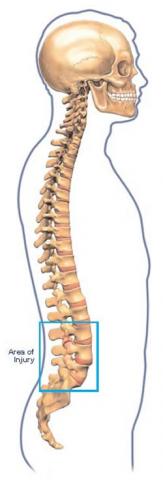Lumbosacral
 Lumbosacral, is a lower back injury that belongs in a category by itself. It is often identified as a “common lower back pain.” As the typical cause of “70% of spine dance injuries” (Heinz, 2005), it is one of the leading (however solvable) impairments for dancers. Lumbosacral is a lower back pain, usually due to “poor stabilization” in dance movements. Frequent muscle imbalance (including weak or tight muscles), un-flexed hip, derriere position, rotation of a vertebrae in the lumbar area, hypomobility, and anything from wearing high heels to uneven leg length are culprits in developing Lumbosacral injuries. This impairment also includes problems in areas like sacral or pelvic rotations and disc problems. Lumbosacral injuries should not be taken lightly and shouldn’t be shrugged off as a “little soreness.” Active response is crucial to a dancer’s career and more importantly, their health: “Any injury which takes you away from dance for more than three days or makes you modify your classes and/or technique repeatedly for more than a week should be evaluated by a physician” (Heinz, 2005). It may seem to go without saying, but it is common for a dancer to sometimes want to “dance through the pain.” With the way the world of dancing is today, with its competitiveness and the strive for perfection, it is a typical mistake made by dancers to try and minimize the seriousness of a dance injury, or even ignore the pain so that they can get on with practice. This is a rising concern for physicians and health professionals, because it makes treatment more difficult to diagnose and remedy. It is also dangerous to keep information from your physician in fear that they may advise you to lay off practice for a while. The more you keep from your physician, the less likely it is that you receive the right treatment to remedy the injury, and not have to pay the consequences later.
Lumbosacral, is a lower back injury that belongs in a category by itself. It is often identified as a “common lower back pain.” As the typical cause of “70% of spine dance injuries” (Heinz, 2005), it is one of the leading (however solvable) impairments for dancers. Lumbosacral is a lower back pain, usually due to “poor stabilization” in dance movements. Frequent muscle imbalance (including weak or tight muscles), un-flexed hip, derriere position, rotation of a vertebrae in the lumbar area, hypomobility, and anything from wearing high heels to uneven leg length are culprits in developing Lumbosacral injuries. This impairment also includes problems in areas like sacral or pelvic rotations and disc problems. Lumbosacral injuries should not be taken lightly and shouldn’t be shrugged off as a “little soreness.” Active response is crucial to a dancer’s career and more importantly, their health: “Any injury which takes you away from dance for more than three days or makes you modify your classes and/or technique repeatedly for more than a week should be evaluated by a physician” (Heinz, 2005). It may seem to go without saying, but it is common for a dancer to sometimes want to “dance through the pain.” With the way the world of dancing is today, with its competitiveness and the strive for perfection, it is a typical mistake made by dancers to try and minimize the seriousness of a dance injury, or even ignore the pain so that they can get on with practice. This is a rising concern for physicians and health professionals, because it makes treatment more difficult to diagnose and remedy. It is also dangerous to keep information from your physician in fear that they may advise you to lay off practice for a while. The more you keep from your physician, the less likely it is that you receive the right treatment to remedy the injury, and not have to pay the consequences later.

